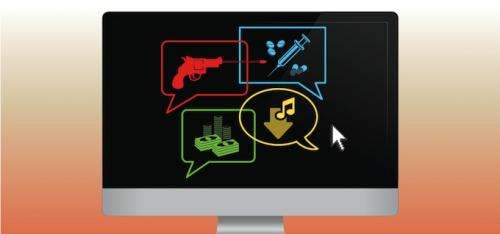Gang behavior on the Internet

Today in the United States, use of the Internet is so widespread that it is almost impossible to apply for a job without a valid email address. More than 80 percent of American adults use the Internet, with massive ramifications for society and the economy. For instance, in 2011, Americans spent $256 billion shopping online.
But not everyone is using the Web to browse Amazon or Skype with grandma. As Internet use has skyrocketed, so has the potential to commit or enable crimes in new ways.
Scott Decker, Foundation Professor of Criminology and Criminal Justice at ASU, is particularly interested in the behavior of gangs. He has studied gangs from multiple angles, from America to Europe, from the 1950s to the present. Recently, he partnered with David Pyrooz, assistant professor of criminology at Sam Houston State University, to study the differences in Internet use among gang members and non-members. Their work fills a gap in the research about online crime.
"We simply don't know how gang members use the Internet for criminal and noncriminal purposes, and what can be done to respond to such use," the researchers write in their paper, "Gang Offending and Online Behavior," which was published last September in the Justice Research and Statistics Association's JRSA Forum.
Funded in part with support from Google Ideas, Decker and Pyrooz conducted 620 interviews in five cities with individuals between the ages of 18 and 30. The subjects were a mix of gang members, former gang members and non-gang members.
The researchers asked about participation in eight forms of online crime, including illegally downloading movies, songs or software; selling stolen property or drugs via the Internet; and coordinating assaults online.
Although downloading music and movies from the Internet violates copyright laws, the activity is commonplace among everyday citizens – in particular, college students.
"Gang members use the Internet mostly in the same way that non-gang members, even college students and non-offending individuals, would use the Internet," says Decker. "A lot of the behavior of gang members is behavior that's typical of their age."
Approximately 80 percent of the three groups interviewed (current gang members, ex-gang members and non-gang members) reported regular Internet use. Among these, 85 to 90 percent of respondents watch YouTube videos, and more than 80 percent use social networking sites.
These numbers aren't too far removed from national averages. However, gang member behavior begins to differ from non-gang member behavior in two ways.
The first is through the posting of threats on various sites on the Internet, which is classified as a "technological form of graffiti." The second is through the use of YouTube in disseminating videos showing violent and illegal acts.
Decker and Pyrooz began their research in January of 2011, looking at five cities: Fresno, Phoenix, Cleveland, Los Angeles and St. Louis.
"They're all cities that have a fairly substantial gang problem and fairly high levels of gang crime," says Decker. "They also represent cities where we have good contacts, so when you do this kind of work you don't just show up and say, 'Hey, I want to meet some gang members.'"
These connections included Father Greg Boyle of Homeboy Industries, an L.A.-based organization that provides services to high-risk, formerly gang-involved men and women. Decker and Pyrooz also collaborated with street outreach workers and prisons in the other cities sampled.
Through their questionnaires, Decker and Pyrooz also relied on standard social science methods to assess whether answers were exaggerated or untruthful.
According to Decker, the common perception is that an individual will lie to understate the degree of their involvement in crime. This might be true for typically law-abiding citizens. However, active offenders tended to exaggerate their involvement in crime rather than understate it.
To combat this, the researchers would ask the same question twice in different parts of the survey, as well as phrasing the question in different ways to compare answers and test for honesty.
In addition to research regarding online gang behavior, Decker is collaborating with the National Science Foundation in a two-year study examining the first federally funded gang intervention in the United States.
Decker will be tracking individuals involved in that program, which began in Boston in the 1950s, to assess where they are now and how their lives have changed.
Provided by Arizona State University



















